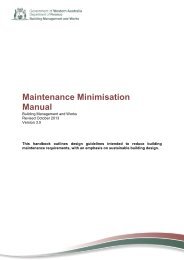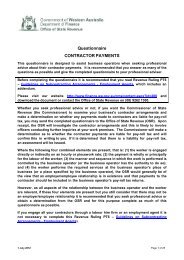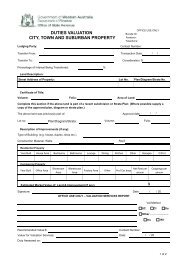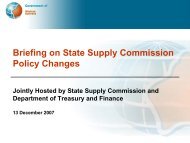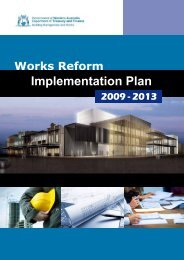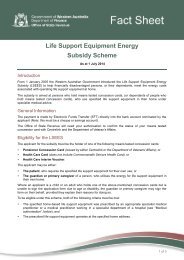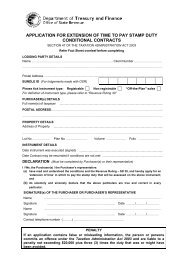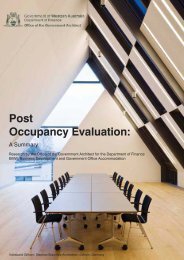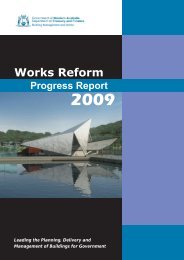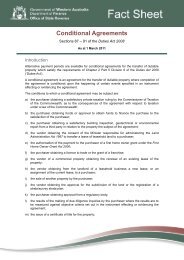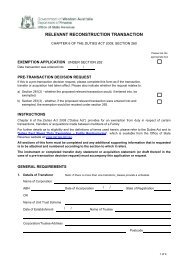Renewable Energy Handbook 2010 - Department of Finance - The ...
Renewable Energy Handbook 2010 - Department of Finance - The ...
Renewable Energy Handbook 2010 - Department of Finance - The ...
You also want an ePaper? Increase the reach of your titles
YUMPU automatically turns print PDFs into web optimized ePapers that Google loves.
A 2.1 Resources Availablein Western AustraliaWestern Australia is generously endowed withrenewable energy resources. Sunshine and wind areplentiful and there are a number <strong>of</strong> locations throughoutthe State where bioenergy, hydro, wave, tidal andgeothermal energy resources are potentially available.<strong>The</strong> use <strong>of</strong> renewable energy within WA is growingin signifi cance for a number <strong>of</strong> reasons, but mainlyin response to programs addressing concernsabout greenhouse gas emissions. In the State’s mainelectricity grid, the SWIS, the proportion <strong>of</strong> totalelectricity consumption met from renewable energyhas increased from less than one per cent in2002/03 to fi ve percent in 2008/09.<strong>The</strong>re is a wide range <strong>of</strong> both large-scale andsmall-scale applications for renewable energy in thisState, although the commercial success <strong>of</strong> these varies.In order to be commercially successful, renewableenergy technologies and products must be technicallydeveloped, appealing to the market, cost-competitiveand supported by a signifi cant resource base.OFFICE OF ENERGYRENEWABLE ENERGY HANDBOOK <strong>2010</strong>Small wind energy, geothermal heat pumps,hydrothermal energy, and tidal energy have high levels<strong>of</strong> technical development, but low levels <strong>of</strong> marketuptake. Hydrothermal energy and tidal energy areconstrained by the limited size or isolation <strong>of</strong> theirresource base. New large-scale hydro-electricdevelopments have limited potential to be commerciallysuccessful in Western Australia. Premium sites havealready developed and new projects are subject toconcerns over their potentially negative environmentalimpacts. Small wind power generators are uncompetitivecompared against conventional fuels and power sources,and are more suited to <strong>of</strong>f-grid applications.Solar thermal electricity, hot dry rocks, wave energy,and fuel conversion technologies such as fuel cellsand hydrogen fuel technologies are pre-commercialtechnologies, with lower levels <strong>of</strong> technical developmentand market uptake. All <strong>of</strong> these, however,are supported by large resource bases.A 2.3 Utilisation inWestern Australia55RENEWABLE ENERGY IN WESTERN AUSTRALIAA 2.2 <strong>Renewable</strong> <strong>Energy</strong>Technology DevelopmentSolar hot water, bagasse-fi red and bioenergy-basedgeneration; and large wind energy are technologicallymature and commercially viable and, in manyapplications, have high levels <strong>of</strong> both technicaldevelopment and market uptake.Liquid bi<strong>of</strong>uels, cogeneration, enabling technologies,remote area power supply (RAPS), small hydro-electricity,and photovoltaics (PV) are less commercially mature.<strong>The</strong>se have high levels <strong>of</strong> technical development butlower levels <strong>of</strong> market uptake, and are less competitiveagainst conventional fuels and power sources.<strong>The</strong>se technologies are supported by substantialresource bases.A 2.3.1 REMOTE AREA POWER SUPPLY(RAPS) SYSTEMSIn Western Australia, stand-alone and hybrid RemoteArea Power Supply (RAPS) Systems are used widelyto provide power through the use <strong>of</strong> solar energysystems. Examples <strong>of</strong> where they are used includeholiday homes and shacks, boats and recreationalvehicles, small rural farms (single homes), large stationhomesteads (with multiple residences), remoteAboriginal communities, small mining operationsand various telecommunications applications.Most renewable energy RAPS systems are installedin remote areas <strong>of</strong> Western Australia, where thepenetration <strong>of</strong> renewable energy systems on pastoralstations is now 34 per cent. Surveys show that thereis a growing acceptance <strong>of</strong> remote area powersupply technologies, which is also being refl ectedby bigger systems recently installed.



